Atrophy, But Not Entropy
 Tuesday, April 26, 2011 at 07:58PM
Tuesday, April 26, 2011 at 07:58PM When I was thirteen, I drew my first self-portrait. I began with a large red rectangle, crosshatched to match the red leather in my newly refurbished electric wheelchair. I attached two oblong flesh-tone spheres to the base of my rectangle to represent my useless, dangling legs. Each leg was punctuated by a pure white circle: my sneakers did not contact the ground so the soles remained crisp and unblemished. Somewhere near the top of the rectangle I drew my left arm and wrapped it around the joystick that controlled my wheelchair. Nothing else seemed necessary; it did not occur to me to draw my face.
Mirrors in bathrooms, classrooms, and mall dressing rooms were never at my height. I saw flashes of my face, part of my forehead, the curve of my jaw line—never enough to leave a lasting impression. Full length mirrors produced distorted reflections usually reserved for carnival fun houses. The body that stared back at me was a knobby frame so minimally developed that it seemed as though the bone could have pierced through the skin any moment. The twists and turns of this body seemed to alter with every viewing. Sometimes my body deflated and curved to the right, sometimes it leaned to the left. My limbs often morphed into incredibly awkward positions as a result of shifting weight distributions and muscle spasms. Corrective braces painfully forced my body into positions that could only be maintained in short bursts with significant mechanical assistance. These devices created illusions of my body as it ought to look and encased my flesh in a plastic prison.
The Chair was the focal point of any reflection, picture, or representation of me. Eyes, including my own, were inevitably drawn to the impressive machine that kept me mobile. The Chair offered me vital stability, but consumed my body in a system of restrictive supports. My feet floated aimlessly on platforms or were strapped down. My chest and hips were supported by a series of guides that kept everything in proper alignment, but obscured those body parts from view. I knew The Chair did not constitute my identity as a person, but I resented its omnipresence in my treasured memories, in the pictures I took with friends and loved ones, and especially in the fabric of my self image.
Paradoxically, I relished the opportunities facilitated by The Chair: I attended classes, participated in musicals, visited friends, went to restaurants and bars (at least the accessible ones), and conquered college. Throughout high school and college, I spent nearly fourteen hours a day in The Chair attending to the various activities and responsibilities of a student. The Chair enabled me to experience the world even as it restricted and concealed my body from that world. People seemed to respond to The Chair; they complimented me on the look and function of the machine as I guided it through obstacles and traffic. All of the comments about my “hot rod” or “sweet ride” cemented the idea that The Chair was an essential part of this person called “Dave”.
When I graduated from college a few years ago, I had had enough. The aging process and lack of physical exercise had deteriorated my functional abilities. I could no longer use a walker or canes with any sort of proficiency, and even the slightest amount of pivoting or weight bearing was problematic. So, I restarted physical therapy, determined to reengage those parts of my body that had been coerced into dormancy. I knew I would never be free of The Chair, but the body inside of it could no longer be ignored.
Before any sort of routine could be assembled, I needed significant improvements in range of motion and tone reduction in a few of my major muscle groups. My hamstrings had shortened and tightened, preventing significant knee extension. I could not actively straighten my legs well enough to facilitate meaningful independent weight bearing. My adductor and hip flexors had become so spastic that I crossed my legs in a scissoring motion every time I tried to take a step in a walker. My legs crushed any device or hand that attempted to separate them. My trunk muscles had all but withered away thanks to my dependence on lateral chest guides in my wheelchair and back braces meant to hold me in the optimum posture.
No amount of therapy or effort can completely reverse these breakdowns. Once a certain amount of functionality is lost, those muscles become fixed and frozen within a limited range. My treatment is focused on preventing these scenarios as much as possible and working within the threshold of my ability to achieve independent motion. Therapy engages my entire body and reminds me that I possess a physical reality that does not involve wheelchairs, braces, or any other gadgets.
I am determined to document this renaissance, to share my narrative with anyone interested in reading it, to confront the specters of the past and to grapple with the indefinite future. Recording my recollections is important, but pictures allow me to transcend the limits of firsthand experience and witness my body at work.
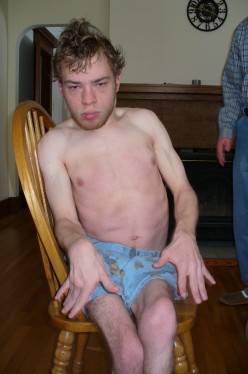
I took this picture to capture my attempt to sit without any supportive devices. I raised my arms off of the chair to force my back and trunk muscles to engage and resist the instinctive temptation to put my body weight on my arms. The muscle tone in my lower body creates an automatic reflex which causes my muscles to move in a particular way, often producing the exact opposite of the movement I am trying to achieve. In order to move left, I have to fight the inclination to move right. Significant amounts of concentration are required to enact any movement so I remain a gaunt man. I have not sustained a weight gain, in fat or muscle, since I was twelve years old. As long as my nerves continue to misfire and compound my muscle tone, my body will continue to consume itself even as I strive to expand the threshold of my abilities.
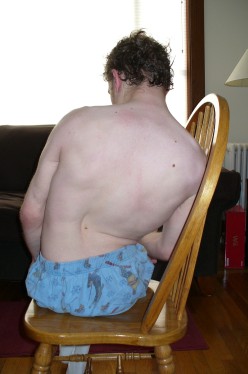
This is the curvature in my spine, my scoliosis. I cannot overcome this curve to straighten myself, so I usually wear a Thoracolumbosacral orthosis to correct this curve and keep me upright. However, using this brace has caused all of the muscles normally involved in keeping me upright to atrophy. Consequently, I do not wear the brace all the time, and use physical therapy as a means to exercise those neglected muscles.
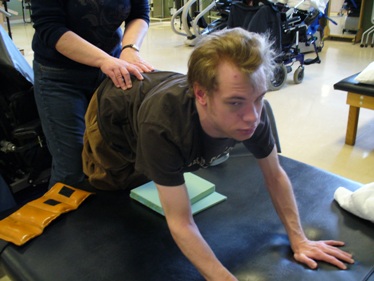
Therapy begins with the quadruped position—my version of a push-up. It forces me to bear the weight of my body on my arms and knees while also elongating my trunk muscles and hip flexors. These muscle groups are all involved in maintaining balance. Typically I perform this exercise in sets of three for as long as I can hold it. Quadruped is not painful, but it is exhausting. While I'm holding this position, I instinctively hold my breath. Eventually, I feel acid build up in my muscles and I hit the mat. I try to make a concerted effort to force myself to breathe, but whenever I do, I invariably lose my grip. In a certain sense, physical therapy is a process of learning how to do things correctly. My form of cerebral palsy produces significant gaps in motor planning, which makes it important for me to perform these exercises to understand the basic elements of motion and muscle operation.

Next, I push myself up into the sitting position pictured above. The biggest challenge is swinging my feet over the edge of the mat and planting them on the ground. From there, I use my arms to push myself up on my left side. It bothers me that my right side is not strong enough to complete this side-sit maneuver, but at a certain point, the desire to complete the task and sit up overwhelms even my ideals. Once I am sitting up, I can remain in the above pose for several minutes, unless some noise causes my startle reflex to engage and I lose all sense of balance. Sitting is pleasant, but is only the prelude to the difficult centerpiece of my routine: standing.

Standing in the EZ Stander accomplishes a few goals. First, it allows me to bear a significant amount of weight to my legs, which aids in the treatment of my lower-body osteoporosis. The knee pads on the stander straighten and extend my knees as far as they can tolerate. Occasionally, I reach up and hang things on a pegboard to practice extending my upper body while my lower body is properly aligned. I can stand for approximately fifteen minutes before the pain becomes overwhelming. As active and invigorating as this regimen is, it still feels insufficient. Gains in range of motion are measured in degrees on a protractor, which do not translate into functional ability.
To hasten progress and unlock new potential, the tightest groups of my muscles were injected with botox. 650 milliliters of botox were dispersed through a series of injections to my hamstrings, quads, hip flexors, and groin muscles. The botox weakens the footpads, the nerve sites at the base of my muscle tissue that carry spastic impulses and consequently gives me greater control over my muscles.
When I returned to physical therapy a few days after the procedure, I took a few heavily assisted steps in a walker for the first time since childhood. I was able to move my legs individually and overcome the muscle tone that had forced them to move jointly.
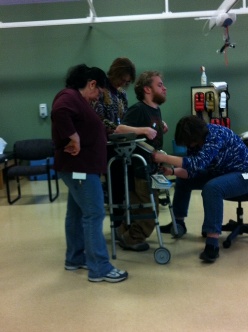
The adductor tone in my right leg remained problematic. When I lifted my left foot, my right foot attempted to step forward and curved backward. My therapist had to help me kick my right foot forward while another therapist stabilized my trunk from the rear. My trunk muscles and upper body were simultaneously working to try and keep me standing upright. Coordinating these activities gave me a new appreciation for the wonder of motion, the mysterious sequence of interlocking parts and processes through which humans move.
My excitement was restrained by the knowledge that the effects of the botox will be temporary. Eventually my muscle tissue will be subject to the usual amounts of spasticity and tone, but the exact timetable remains unknown. The common estimate is that the effects will last four to six months before complete reversion takes place. In the meantime, I began rounds of serial casting to stretch my legs over long periods of time so new responsive muscle tissue will grow and replace the older, unresponsive, spastic tissue.
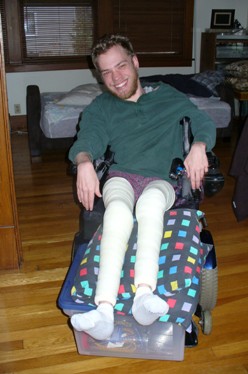
These fiberglass casts extend from the top of my thigh to the top of ankle and are worn for four day increments. Elevating my legs in the manner pictured above is essential to maximizing the stretch. It is a slight stretch, well within the limits of my tolerance, but as the hours and days compound, I can feel the pushback of my muscles yield to the stretch. My knees are under a fair amount of corrective straightening force so some soreness is inevitable. Overwhelming soreness however, could indicate a skin breakdown, which could quickly develop into a dangerous infection. Consequently, I must be aware of my pain level at all times.
The biggest difficulty created by the casts is the challenge of balancing on the toilet. My legs are extended outwards which causes me to become pinned against the back of the toilet. It is difficult to lean forward forward using my weak core and trunk muscles, though the grab bar in my bathroom does give me leverage and stability. It is not a comfortable situation and I use my portable urinal whenever possible.
My second (and hopefully final) round of casts began yesterday. While it is unlikely, that this round of casts (or any successive round of casts) will produce the level of improvement, I experienced in the first round of casting, there is still potential for continued improvement. Regardless of the results, I am eager to return to physical therapy and test the limits of my regained abilities, however temporary those gains might be.
Exploring the details of this past year of therapy has forced me to examine and evaluate my body closely. Understanding the strange mechanics of my body does not nullify the shock I experience when I gaze upon this frame. My ribcage forms a twisted textural relief on otherwise bland chest. My arms flounder haplessly about. My legs simply exist; contracted and compressed into the positions they have occupied for decades. Hating my body is an absurd reaction to a permanent visual reality and a surrender to some idealized standard of beauty that no person can ever match, but I do hate the limitations of my body and the stagnancy of my appearance.
Integrity demands that I be forthcoming about my frustrations and resist the temptation to simplify complex reactions into affirmative platitudes. Sharing my personal narrative, my pictures, my recollections connects me with readers and is a victory. I can place my current challanges within the framework of past experiences as I work to secure an independent future.
Reader Comments (9)
Dave, please keep writing. I admire you very much.
Dave,
This is amazing. Thank you for sharing. I am moved, fascinated, and in awe.
Joy,
Alix
Dave, you're being as strong and inspirational as anyone could ever be. You deal with your adversity with a optimism I can only envy. Keep going.
-josh
I wish I could say more, but all I can come up with is thank you for sharing. Both your actions and your writing are moving and inspirational.
Wow. What an emotional article.
Brutal honesty is good. Not only does it allow for a more acute self-realization (there's your philosophy) but as a historical document/personal narrative it also makes this more valuable. People don't say what they really think anymore and hide behind a created self image without presenting themselves as they really are either to others or even themselves. Thanks for the pictures. It helps bring this blog to life.
Of course, you do look a bit like Kermit the Frog in that last picture.
Thanks, everyone! I appreciate all the kind words. All of you commentators do things to make my life a bit more pleasant, (and all of you are engaged in professions that do promote The Good in some meaningful way, so please keep doing what you are doing!
Pete- I often wander around the house wondering "Why are there so many songs about Rainbows?" Kermit is a hero of mine.
Dave,
Bravo. Don't ever, ever forget how brave you are. And do try not to let that go to your head, please.